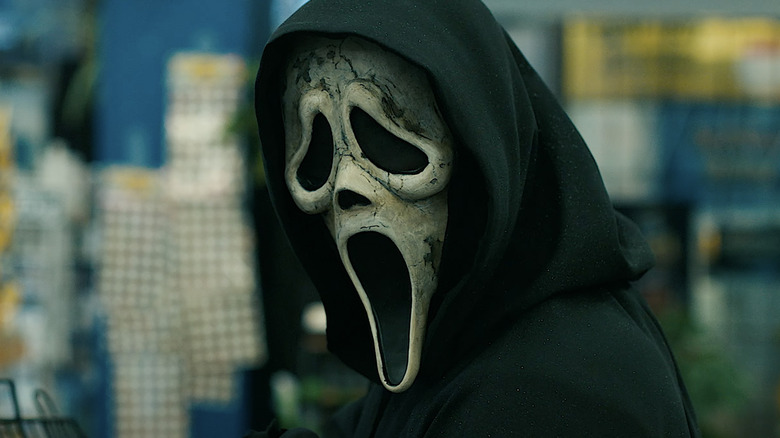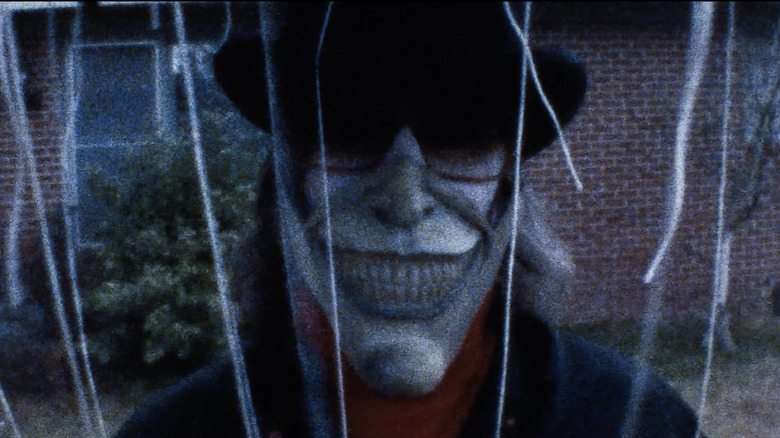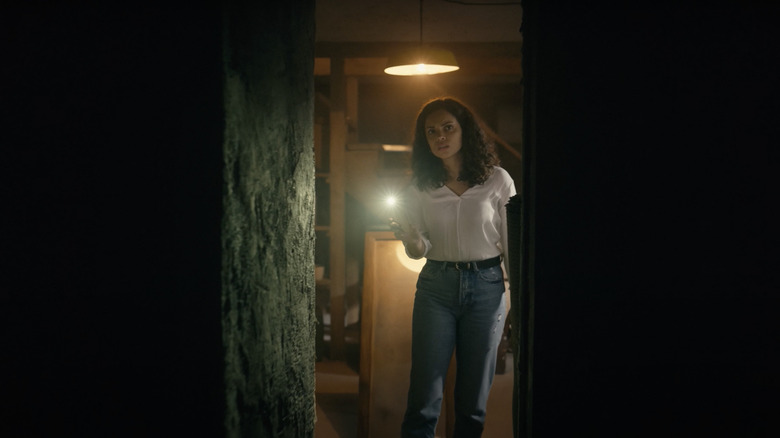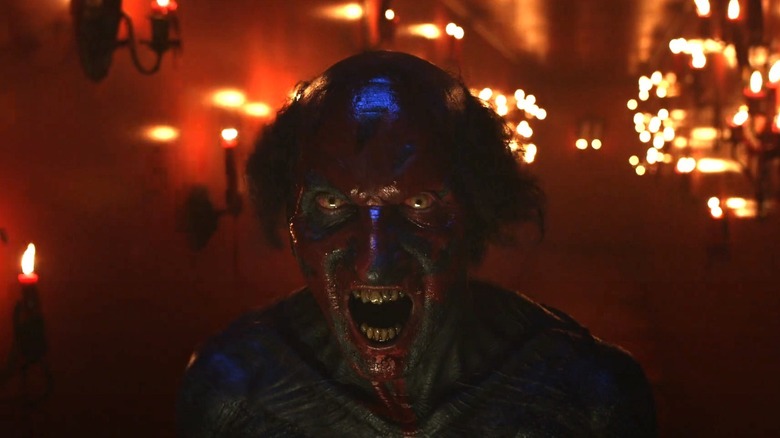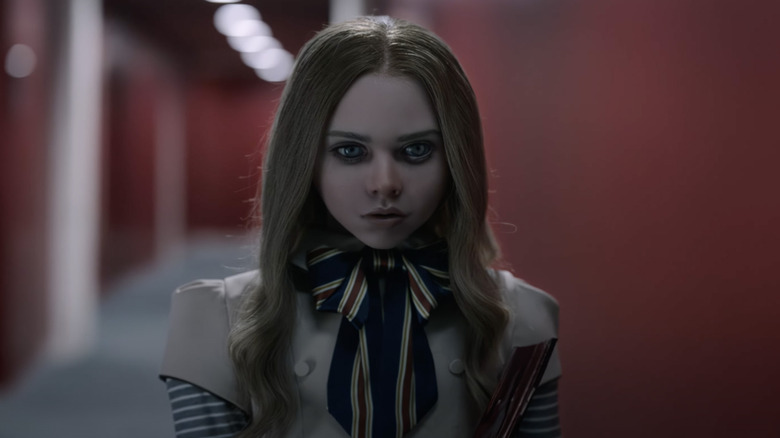Scream VI, Insidious 5 - Why It Pays Off For Hollywood To Support Horror Blockbusters
Horror blockbusters like "Scream VI" and "Insidious: The Red Door" are making big bucks at the box office, signaling a profitable (and creatively inspiring) future for the genre.
There's something compelling about sitting down in a darkened theater, surrounded by a hundred strangers, as you all brace the latest thrills and chills from Hollywood. There's a comfort in knowing that, no matter how scary a film is, others are experiencing the same terror as you — making it all the more palatable. Scary movies have always done well at the box office, thanks in part to the communal experience that they demand. Horror films live and die based on their vibe and the effect they leave upon the audience, which is why the first question that's always asked is: "how scary was it?"
The financial consistency of horror films in the 2020s is particularly compelling. COVID-19 served as a cultural reset for audiences around the world. Since 2020, trends have come and gone, and certain genres (romantic-comedies) have all but disappeared from multiplexes, but horror projects from franchises like "Scream" and "Insidious" are making waves at the box office, with recent entries grossing over $165 million worldwide. Even non-IP films like "M3GAN" and "Smile" are casually bringing in viable hauls. This positive trend isn't dependent on subgenre, A-listers, or even MPAA ratings — a large numbers of horror films are bringing audiences back to cinemas, turning potential duds and would-be streaming service exclusives into bonafide blockbusters.
As Hollywood continues to double down on reboots, superhero sequels, and large-budget franchise outings, it has become clear that audiences have a genuine craving for horror films that just won't subside. If studios want to return to pre-pandemic level receipts, they should double down on what audiences are openly accepting.
Horror films are rebounding in the post-COVID era
When it comes to box office juggernauts, cinephiles immediately latch onto four-quadrant blockbusters that speak to the masses like "Avengers: Endgame," "Titanic," or the recent "Top Gun: Maverick." These films are quintessential blockbusters that have both hardcore fans and casual cinemagoers reeling with excitement, providing them unmatched spectacle. But when it comes to consistency, the so-called "blockbuster" that appeals to all can sometimes falter. This year, films like "Transformers: Rise of the Beasts" and "Mission: Impossible — Dead Reckoning Part One" have underperformed, despite being part of billion-dollar franchises.
When it comes to consistency, Hollywood can (and always has) bet on horror films to churn out a profit. But in the post-pandemic era, the genre is soaring high, while so-called surefire hits, like "Fast X" or "The Flash" are underdelivering. In 2016, the horror genre accounted for $512 million of the domestic box office share, with only one film ("The Conjuring 2") crossing over $100 million, per The Numbers. A year later, thanks to breakout hits like "Get Out" and "It," horror reached a whopping $1 billion domestically. But then a dip began to manifest, with 2018's films raking in $851 million, and 2019's offerings resulting in a total shy of $800 million. Horror films were certainly profitable but a downward trend was apparent.
But in the post-pandemic era, horror films are picking up the slack, especially when compared to theatrical outings from genres like comedy and drama. In 2022, The Numbers reports that horror was the third most profitable genre, just behind action and adventure. That year, horror films boasted a domestic haul of $634 million, and this year, the total stands shy of $500 million. As the box office continues to rebound from COVID-19, it's clear audiences are giving horror a chance.
Horror films have enthusiastic audiences
Though it may be hard to reason with certain stringent viewers who don't "do horror," it's fair to say that horror films are some of the most diverse projects which dominate multiplexes. Within horror, there are a number of subgenres, each of which can appeal to a specific or broad crowd. Consider how gruesome, gory slashers can dominate alongside tense, slow-burn supernatural thrillers. This diversity in theme and subject is what helps the genre stick out to audiences. And while it's unfair to box in genres like action into specific boxes, the truth is that sentiment seems to suggest that most contemporary blockbusters feel the same. Beyond that, horror continues to boast enthusiastic fandoms who are always willing to accept risks.
Horror is one of the few genres that can succeed based purely on word of mouth. In 2022, unlikely projects like the nasty "Terrifier 2" and mind-bending "Barbarian" became instant cult classics thanks to positive word of mouth from enthusiastic fans who shared just how bonkers and preposterous they were. "Terrifier 2," which debuted to $805,000 in mid-October, grew its footing in subsequent weeks thanks to horror enthusiasts jumping on the bandwagon. In its second and third week, the flick earned $1 million and $1.7 million, respectively.
It's the same for "Barbarian," which opened to $10 million last year, but grew as word of mouth determined the Zach Cregger film to be a must watch. It boasted stellar legs, dropping only 38% in its sophomore weekend, and even managed to grow the number of theatres it played at during that time. And while horror can be broad, it has a dedicated and consistent fandom. Audiences pay attention to the horror trailers that play before their screening, and make it a point to watch the next major project.
Horror films are consistently cheap unlike other blockbusters
Hollywood is in the business of making money and that's only possible if projects are actually profitable. The last few years (thanks in part to COVID-19) have seen inflated budgets for major blockbusters. "Indiana Jones and the Dial of Destiny" boasts a budget north of $290 million, per Deadline, and the same goes for "Mission: Impossible — Dead Reckoning Part One." The former has barely turned a profit, as its worldwide total is $370 million. And for "Dead Reckoning," the film has finally grossed over $500 million, but with Hollywood accounting, its anyone's guess to determine the spy thriller's profitability.
In 2023, it's more evident than ever that budgets need to be trimmed. Horror has always managed to bring in hundreds of millions with minimal budgets, but it's the post-COVID receipts that should have studios excited to greenlight future projects. While assured, large, tentpole productions are failing to bring in cash thanks to their monstrous budgets, this year's biggest domestic horror play, "Scream VI," managed to bring in over $100 million against a budget of $35 million. "Insidious: The Red Door" was made on a budget of less than $20 million and is on track to make $200 million worldwide. A great non-IP example is this year's breakout hit "M3GAN," which hit $95 million domestically on a budget of $12 million.
With horror films, margins are high when budgets are reeled in. Healthy balance sheets allow studios to take more risks with their overall slates, horror or not. And sometimes, it pays for studios to take risks... 2022's "Smile" and this year's "Evil Dead Rise" were both devised as streaming plays, but when sent to cinemas, they made millions, with "Smile" crossing the $200 million mark worldwide.
Horror films are offering audiences new stories
If the genuine goal is to make money, then Hollywood is on the right path by supporting horror filmmakers and their fans. As horror films continue to prosper, more riskier and interesting projects are given the means to succeed. Take the independent Australian film "Talk to Me" which was snatched up by A24 and given a wide platform. An absolute juggernaut of a picture, the supernatural thriller, which functions as a meditation on grief, has managed to score a worldwide total of $37 million on a budget of $4.5 million. An immersive, heartbreaking project like "Talk to Me" exists in the same landscape as the blockbuster "Scream VI," which proves that franchise plays can succeed if the source material is treated with respect.
Horror has always served as a vehicle for filmmakers to comment on pressing social matters and taboos. With 2023's "M3GAN," writer and producer Akela Cooper boldly painted a picture about the perils of artificial intelligence, while "Scream VI" expertly tackled the importance of not letting trauma define victims. Audiences are eager to see rich, against-the-grain narratives unfold on the big screen, IP or not. Tried-and-tested franchises like "Scream" and "Insidious" are succeeding just as well as new, non-IP fare like "M3GAN," making horror one of the few genres where pre-recognition isn't needed for financial success.
For creatives, this is a boon, as they can take bolder risks, potentially producing the next big horror classic that's not committee-driven. And for studios, this means minuscule budgets and a bit of courage can lead to the next big franchise. Consider how James Wan's "The Conjuring" turned into a billion-dollar, spin-off bearing franchise based on a modest $20 million budget for its first entry. Small risks can lead to big rewards for both studios and fans.
